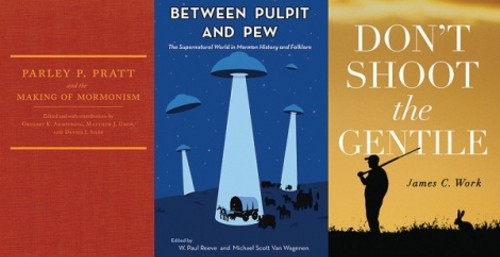Mitt Romney and Jon Huntsman Jr. have both had to answer plenty of questions about Mormon doctrine during their presidential campaigns. One belief that particularly stands out to non-Mormons is the idea that men and women can progress eternally to become like God. In answering that question, Romney and Huntsman might well turn to the writings of Parley P. Pratt, who both share as a common ancestor.
The informative and entertaining Parley P. Pratt & the Making of Mormonism illustrates that besides having a delightfully alliterative name, Pratt helped to develop the doctrine of men and women obtaining divine status, and arguably influenced early Mormonism more than anyone but Joseph Smith and Brigham Young. Of course, Romney and Huntsman may have also inherited the gene for explaining LDS theology from Pratt, since he led the way in the 19th century in writing tracts that expounded on the new faith for the uninitiated while also responding to critics.
Besides Pratt’s influence on doctrine and his prominent writings, his life story has all the makings of an HBO miniseries. He was married to 12 different women at one time or another, some of whom he was sealed to without first getting permission from Smith or Young. Parley getting secretly sealed to a wife—and fathering a child who at least one of his other wives didn’t know about—led to him having a major argument with his brother Orson during a temple session that resulted in the two being sworn enemies for years. Indeed, PPP died at the hands of the jealous, not-yet-divorced husband of Parley’s 12th “wife.” Once Brother Pratt was safely six feet under, Brigham said of him, “He whored.”
While the Pratt book outlines the more formal line of serious doctrinal developments in early Mormonism, Between Pulpit & Pew looks at how faith-promoting rumors and folklore get started and spread through the faith. One of the examples occurred in 2001, in an e-mail circulated about a talk Elder Boyd K. Packer of the Quorum of the Twelve supposedly gave to a youth group in which he said that today’s youth were generals in what Mormons call the “war in heaven” during the pre-existence. Packer’s words were growing in stature and being quoted in sacrament meetings, until Packer issued a statement that said, “I did not make that statement. I do not believe that statement.”
It’s an interesting example of how beliefs can flourish outside of the official LDS priesthood channels, but, unfortunately, that’s the only modern example included in Between Pulpit & Pew. Since the book is mostly written by history professors, much of what is covered occurred in the 19th century. There’s obvious merit in that subject, and people interested in LDS history will certainly enjoy this well-researched book. But, for many other readers, it may have been more interesting to have people from other fields—sociology, psychology, political science, etc.—look at how Mormon folklore originates and gets perpetuated in the age of Facebook and Twitter, how popular Mormon speaker and author Paul H. Dunn managed to pass off fiction as fact for decades, or why many conservative Mormons in the Legislature often seem to be at odds with the official church position on issues such as immigration, or workplace and housing discrimination against gays and lesbians.
The way Mormon beliefs get sorted out can look strange to outsiders, as James Work recounts in his memoir, Don’t Shoot the Gentile. In the 1960s, Work was one of the only “gentiles”—non-Mormons—living in Cedar City while teaching at the College of Southern Utah (now known as Southern Utah University).
Work has some amusing stories about the peculiarities of that time and place, such as how he would stop by the liquor store, show the state-issued license you needed at the time just to buy a bottle of wine, and load up his green station wagon with orders placed by various friends and associates who didn’t want to stop by the store themselves. He would park the loaded vehicle in his driveway with the doors unlocked, and the next morning it would be empty. Work also offers some heartwarming stories about how Mormons befriended him, and how anyone living in Cedar City at the time could count on the community to take care of them.
Work’s various tales never really cohere into an overall theme, and his sense of humor runs into the incessantly corny grandpa variety. When he learns a young man is a returned missionary, he says, “I assumed the term ‘returned’ meant he had been sent back from some country demanding a replacement.” Such humor might be fun for a couple of hours when you see your grandpa at a family gathering, but you don’t necessarily want to go on a road trip with him for 15 hours—or 152 pages.
PARLEY P. PRATT & THE MAKING OF MORMONISM
Edited and with contributions by Gregory K. Armstrong, Matthew J. Grow and Dennis J. Siler
The Arthur H. Clark Company, 2011
352 pages, $45 hardcover
BETWEEN PULPIT & PEW: THE SUPERNATURAL WORLD IN MORMON HISTORY AND FOLKLORE
Edited by W. Paul Reeve and Michael Scott
Van Wagenen
Utah State University Press, 2011
256 pages, $24.95 paperback, $20 e-book
DON’T SHOOT THE GENTILE
By James C. Work
University of Oklahoma Press, 2011
152 pages, $19.95 paperback
More by Geoff Griffin
-
A Family New Year
How to ring in 2020 with revelers of all ages.
- Dec 25, 2019
-
The 12 Arts of Christmas
A delightful dozen options for your holiday entertainment needs.
- Nov 27, 2019
-
Season Kickoff
A look at what's new, or old but great, at Utah's ski and snowboard resorts for the winter season.
- Nov 13, 2019
- More »



